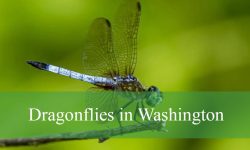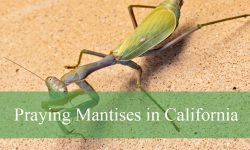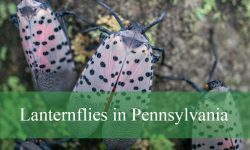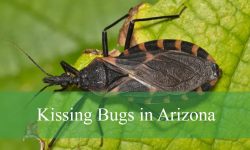Texas is home to an incredible diversity of bird species, thanks to its wide range of ecosystems—from deserts and coastal wetlands to forests and prairies. Among these avian wonders, Birds with Long Tails in Texas stand out for their dramatic silhouettes and captivating behaviors. Exploring the Hill Country or birdwatching along the Gulf Coast often reveals these striking species in action.
Birds with Long Tails in Texas aren’t just visually impressive—they often rely on their elongated tail feathers for balance, aerial agility, and mating displays. From the elegant Swallow-tailed Kite to the charismatic Scissor-tailed Flycatcher, these birds bring energy and character to the state’s diverse habitats, from urban areas to remote prairies.
This article highlights seven remarkable Birds with Long Tails in Texas, complete with pictures and clear identification tips. Learning about these eye-catching species will enhance your birdwatching experiences and deepen your appreciation for Texas’s vibrant wildlife.
Different Types of Birds with Long Tails in Texas
Scissor-tailed Flycatcher (Tyrannus forficatus)
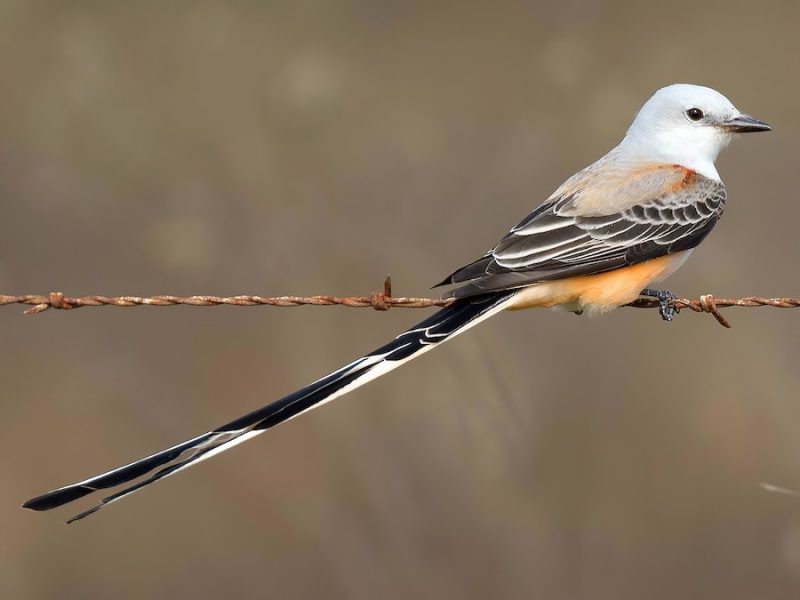
The Scissor-tailed Flycatcher is one of the most easily recognized birds in Texas due to its extraordinarily long, forked tail that can measure up to twice the length of its body. This tail not only helps with balance during agile aerial maneuvers but also serves as a distinguishing feature during mating displays. The tail feathers open and close like scissors, inspiring its common name. This bird exhibits strong sexual dimorphism, with males typically displaying longer tails than females.
Its overall plumage is a soft, pale gray, while the sides and underwings flash a delicate salmon-pink hue when the bird is in flight. The wings are dark and pointed, and its head is compact with a short, thick bill typical of flycatchers. Juveniles tend to have shorter tails and duller coloration, making them slightly harder to identify from a distance. Despite its elegant appearance, the Scissor-tailed Flycatcher is quite vocal and active, especially during the breeding season.
This species is medium-sized, measuring between 14 and 15 inches long, with tail streamers accounting for much of its length. Their wingspan typically ranges from 15 to 16 inches. Their song is a varied series of sharp chirps and buzzes, often described as dry and mechanical. Males frequently vocalize from high perches to mark their territory and attract females during spring and early summer.
In Texas, the Scissor-tailed Flycatcher is widely distributed throughout the central and northern regions during its breeding season, which lasts from late March to early September. Preferred habitats include open grasslands, ranches, farmlands, and roadsides with scattered trees or utility lines, where they can perch and scan for flying insects. After breeding, these birds migrate south to Central America for the winter, often gathering in large pre-migratory flocks by early fall.
Greater Roadrunner (Geococcyx californianus)

The Greater Roadrunner is a unique and iconic bird of the American Southwest, known for its long tail and ability to sprint across open terrain. Its long, stiff tail is often carried at an upward angle and used for balance during high-speed running. This bird’s streamlined body and long legs reflect its adaptation to a terrestrial lifestyle, rarely taking flight unless absolutely necessary. Its movement is swift and purposeful, often observed darting across roads or between shrubs.
The plumage of the Greater Roadrunner is cryptically colored with a mix of brown, black, and white streaks, allowing it to blend seamlessly into desert and scrub habitats. A notable feature is the shaggy crest on its head, which can be raised or lowered depending on its mood or alertness. A patch of bare skin behind the eyes, often blue and red, adds to its distinctive look. Despite its somewhat comical appearance, the roadrunner is a skilled predator capable of catching lizards, snakes, and even small birds.
This bird is fairly large, with a body length ranging from 20 to 24 inches and a wingspan of about 20 inches. It has a harsh, cooing song often likened to that of a dove, along with clattering vocalizations and low, throaty calls. Roadrunners are also known for their clicking or bill-rattling sounds used during courtship or territorial disputes. Most of their vocal activity occurs during the cooler parts of the day, especially early morning and dusk.
In Texas, the Greater Roadrunner is found primarily in the western, southern, and central regions, particularly in areas with arid climates. It thrives in deserts, mesquite scrublands, and sparsely vegetated ranchlands. This bird favors habitats where open ground is abundant and vegetation is low, providing space to run and hunt. Though often seen near roads, it is a naturally wild bird and a symbolic presence in the brush country of South and West Texas.
Green Jay (Cyanocorax yncas)
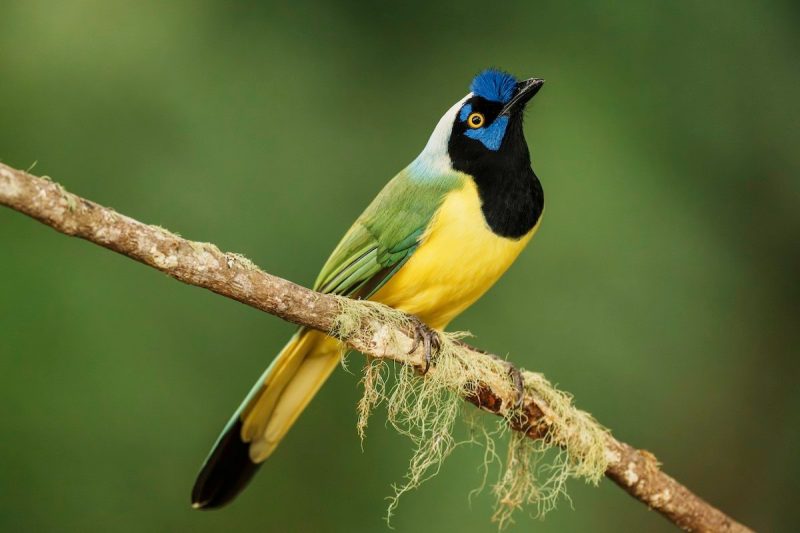
The Green Jay is among the most colorful and tropical-looking birds found in the United States, with its range barely extending into southern Texas. One of its most striking features is its long, blue-green tail with black bands, which it uses expressively during social interactions and displays. This species is highly social and intelligent, often moving in family groups through dense woodlands and forest edges. The Green Jay’s appearance alone makes it a favorite among birders and nature enthusiasts.
Its plumage is brilliantly vivid, combining bright green on the back and wings, a blue crown and cheeks, and a bold black mask across the eyes and throat. The underparts are usually yellowish, and the bill is thick and slightly curved. The green and blue coloration contrasts beautifully with the black facial markings, creating a dramatic and unmistakable look. Juveniles are duller in color and develop full adult plumage gradually as they mature.
Green Jays are medium-sized birds, measuring about 11 to 12 inches in length, with a broad wingspan of roughly 13 inches. They are very vocal, producing a wide range of calls, including whistles, cackles, and harsh churring notes. Their vocalizations are used for group coordination, alarm calls, and maintaining contact in dense vegetation. They are also known to mimic sounds, adding to their reputation for intelligence and adaptability.
In Texas, the Green Jay is found exclusively in the southernmost parts of the state, particularly in the Lower Rio Grande Valley, including areas like Santa Ana National Wildlife Refuge and Bentsen-Rio Grande Valley State Park. They inhabit subtropical thorn forests, mesquite thickets, and riparian woodlands where dense cover and food sources are plentiful. Because their U.S. range is so limited, the Green Jay is considered a prized sighting for birders visiting South Texas.
Long-tailed Grackle (Quiscalus mexicanus)
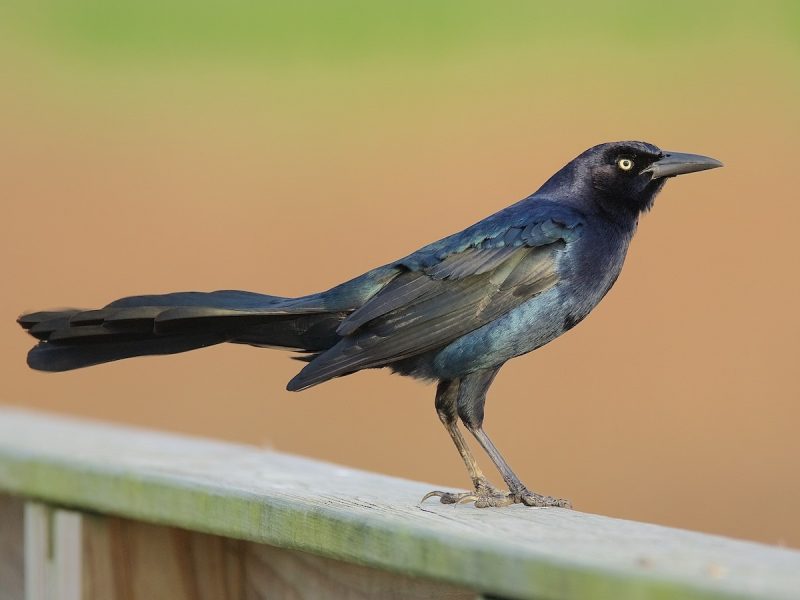
The Long-tailed Grackle, commonly known as the Great-tailed Grackle, is a familiar bird throughout much of Texas and is especially noticeable due to its loud calls and flashy tail. The tail is particularly long in males, fanning out dramatically and often held in a V-shape when the bird is displaying. It plays a crucial role in mating displays and dominance behavior, with longer tails often signaling stronger individuals. Males frequently strut around with their tails raised, giving them a flamboyant appearance.
Male Great-tailed Grackles have glossy, iridescent black plumage that shimmers with hues of purple, blue, or green in the sunlight. They also have piercing yellow eyes and a strong, tapered bill. Females, in contrast, are smaller and much plainer, with brown plumage and a subtle buff-colored throat. This strong sexual dimorphism makes it easy to distinguish between the sexes, even from a distance.
These birds range in length from 15 to 18 inches, with males being significantly larger than females. Their vocalizations are among the most varied and peculiar in the bird world, including whistles, creaks, squawks, and mechanical-sounding calls. They are extremely social and often gather in large, noisy flocks, especially in the evening when they roost communally in trees near water or urban settings.
In Texas, the Long-tailed Grackle is ubiquitous. It can be found in nearly every environment except dense forests or high elevations. Common habitats include city parks, shopping center parking lots, agricultural fields, and lakeshores. Their adaptability to human-modified landscapes has allowed their population to expand rapidly, and today they are a permanent and noisy presence in towns and cities across the state.
Common Raven (Corvus corax)
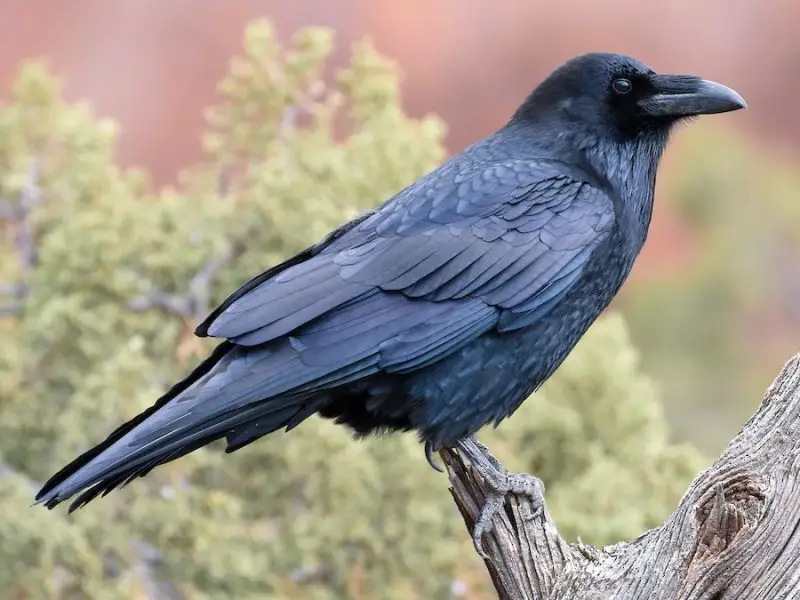
The Common Raven is the largest songbird in North America and a master of survival in harsh and rugged landscapes. Its tail is long and wedge-shaped, especially noticeable when the bird is soaring or gliding. This wedge-like shape helps differentiate it from similar species like the American Crow, whose tail is more squared-off. Ravens also have long, pointed wings that contribute to their powerful and graceful flight.
Entirely cloaked in black, the Common Raven has a shaggy throat, heavy bill, and strong legs. The plumage often shines with subtle blue or purple highlights in sunlight. Its thick neck and deep-set eyes give it an intelligent, observant look. These birds are also incredibly smart, known for using tools, solving problems, and mimicking sounds.
Measuring between 22 and 27 inches in length with a wingspan of up to 53 inches, ravens are noticeably larger than crows. Their calls are deep, resonant, and varied—ranging from throaty croaks and rattles to popping and clicking sounds. The raven’s vocal range is astonishing and reflects its complex social structure and high intelligence. It often uses its voice to communicate over long distances in mountainous terrain.
In Texas, Common Ravens are mostly confined to remote areas of West Texas, especially mountainous and desert regions such as Big Bend National Park and the Davis Mountains. They prefer open landscapes where they can forage for a wide variety of foods including small animals, carrion, and human refuse. Their ability to adapt to diverse diets and environments helps them thrive in places where few other birds can survive.
Swallow-tailed Kite (Elanoides forficatus)
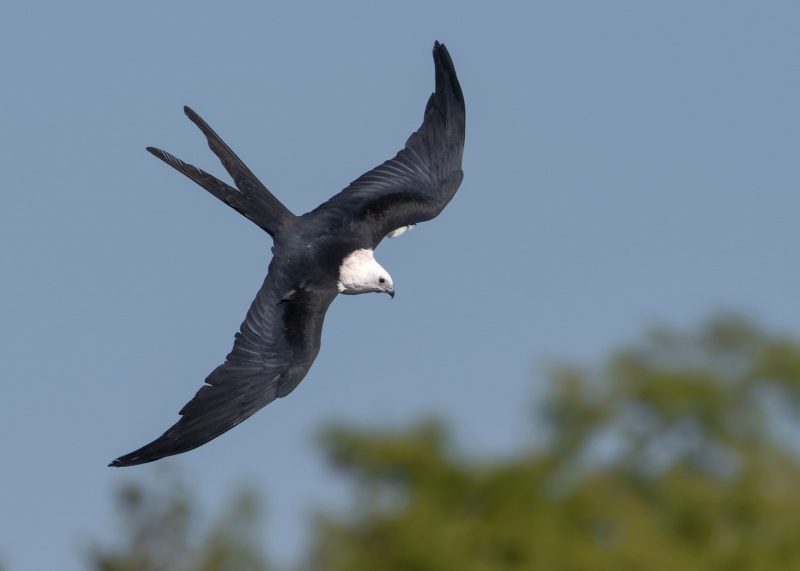
The Swallow-tailed Kite is among the most elegant and breathtaking birds seen in Texas skies, though its presence in the state is rare and mostly seasonal. Its most defining feature is its long, deeply forked tail, which it uses with incredible precision during flight. The tail acts like a rudder, allowing the bird to steer effortlessly while gliding or diving over forests and wetlands. Combined with its slender wings, the kite’s silhouette is unmistakable.
This raptor is striking in appearance, with a snow-white head, body, and underparts, contrasted by jet-black wings and tail. From below, it looks almost like a cross gliding in the sky. Its small beak and head belie its fierce predatory nature—it feeds mostly on insects, small reptiles, and amphibians, all caught midair or plucked from treetops. Its flight style is smooth and buoyant, more like a swallow or tern than a typical hawk.
Swallow-tailed Kites are medium-sized raptors, measuring about 20 to 25 inches long with a wingspan of over 4 feet. They are largely silent, but may occasionally emit high-pitched whistles during courtship or territorial flights. These birds are highly aerial and rarely perch in open view, making sightings exciting and often brief. Their graceful presence makes them a favorite among birdwatchers when they pass through.
In Texas, the Swallow-tailed Kite is occasionally seen in the eastern part of the state, particularly during spring and summer migration. It may show up in areas such as the Big Thicket, Sam Houston National Forest, and along river corridors with mature forests. Although not a common breeder in Texas, individuals may wander through the state while moving between the Gulf Coast and their more stable breeding grounds in the southeastern U.S.
Loggerhead Shrike (Lanius ludovicianus)

The Loggerhead Shrike may look like an ordinary songbird at first glance, but its behavior sets it apart as one of the few passerines with raptor-like habits. It sports a long, narrow black tail with white outer feathers that flash in flight or when it fans the tail during displays. Its tail helps with balance and agility, especially when swooping down on prey or navigating through shrubs and grasslands.
It has a crisp gray body, white underparts, and a bold black facial mask that gives it a striking appearance. The bill is thick and slightly hooked, more like that of a small hawk than a typical songbird, adapted for catching and dispatching insects, small rodents, and even lizards. Despite its small size, the Loggerhead Shrike is a fierce predator and uses its beak and intelligence to capture and subdue prey.
This bird measures about 8.5 to 9 inches in length with a wingspan of approximately 11 to 12 inches. Its calls include a variety of harsh buzzes, rasps, and chattering notes. Though not musical, its vocalizations serve to communicate territory and attract mates. One of its most notable behaviors is impaling its prey on thorns, barbed wire, or twigs—a method that helps it tear apart its food and store it for later.
The Loggerhead Shrike is found throughout Texas, favoring open habitats like grasslands, pastures, farmlands, and desert scrub. It often perches on fences, utility lines, or isolated shrubs where it scans for movement below. While once more common, its numbers have declined in some areas due to habitat loss. However, Texas remains one of its strongholds, offering ample space and prey for this small but mighty predator.


